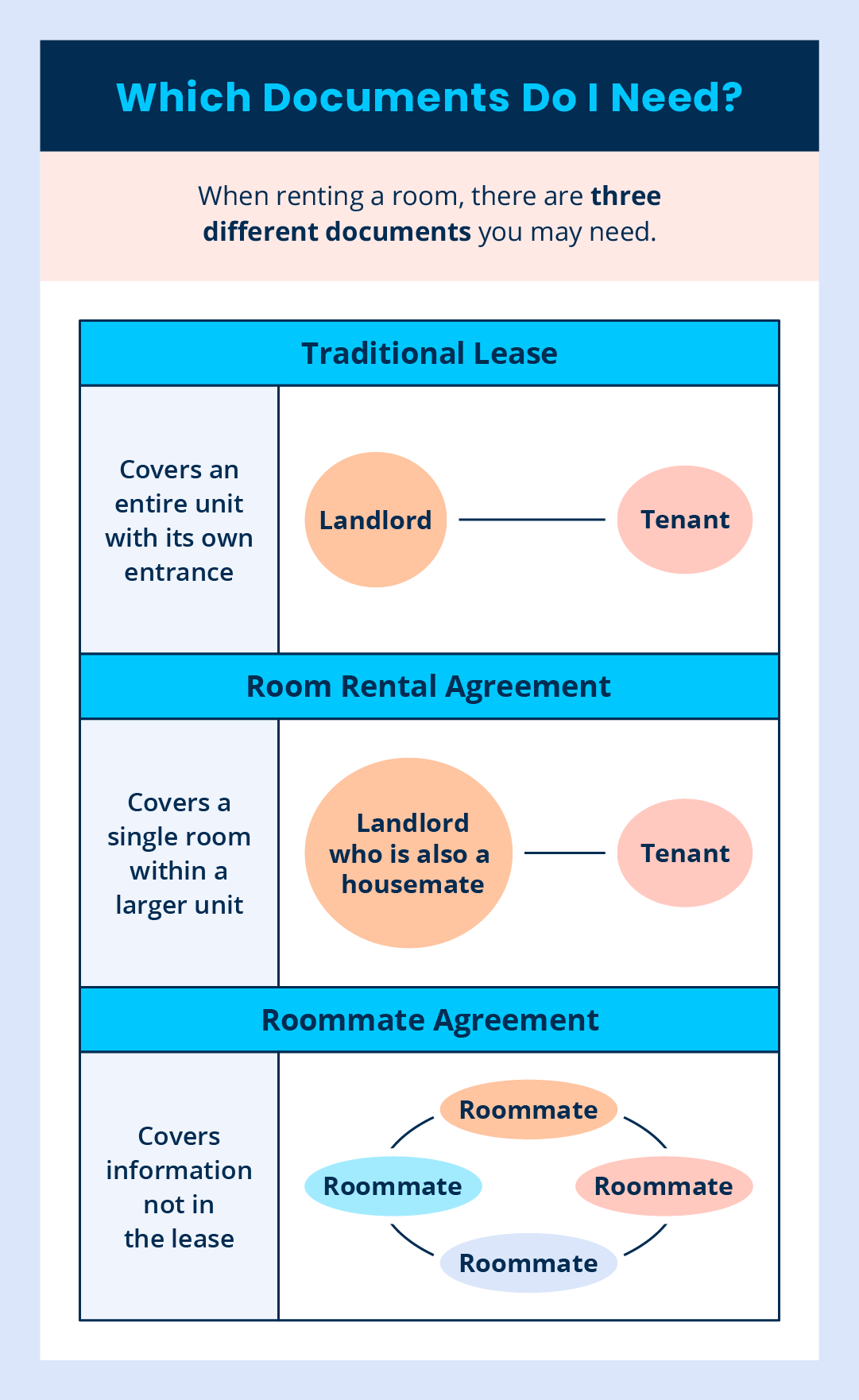Perhaps you need to supplement your income and don’t want to pick up a time-consuming side hustle. Or maybe you’re moving in order to start a new job and need to sublease your room in a shared apartment to someone else. Whatever the reason you’re considering renting out a room, a room rental agreement is a must to protect both you and your tenant during your tenancy, just like a typical residential lease agreement.
In this article, you’ll find:

What is a Simple Room Lease Agreement?
A simple room lease agreement is a contract between you and the person to whom you are renting a room within a rental unit. It outlines the rules and responsibilities of both you and your tenant.
When you’re both a housemate and the landlord, the person you’re renting to is only renting the room they will stay in, and the rest of the dwelling is considered common space. Once signed, a room rental agreement is a legally binding document that protects both you and your tenant.
A room rental agreement is not the same as a sublease agreement. For more information about the sublet process, which has its own set of rules, check out this subleasing guide for both homeowners and tenants.

How is a Room Rental Agreement Different Than a Traditional Lease or a Roommate Rental Lease Agreement?
The term “room rental agreement” often gets confused with the terms “traditional lease” and “roommate agreement.”
Both a room rental agreement and a traditional lease agreement are legally-binding rental contracts between a tenant and the person from whom they are renting. However, there are distinct differences.
A room rental agreement:
- Covers a single room in a larger dwelling, while a traditional lease covers an entire unit.
- Is between a renter and a landlord who is also a housemate, while a traditional lease is between a renter and a landlord who does not reside in the rented unit.
- Is for a shorter term (month-to-month or week-to-week), while a traditional lease typically lasts for six months or a year.
Meanwhile, a roommate agreement:
- Is signed by all tenants living in the dwelling and not the property owner.
- Covers topics not related to the lease, such as sharing the cost of communal items (e.g., cleaning, toilet paper, communal groceries, cleaning supplies), or defining house rules like quiet hours and temperature settings.
When is a Room Rental Agreement Needed?
A room rental agreement is needed when a person rents out a private room to a tenant or a primary tenant sublets their room to a subtenant.
Any time you rent a room to someone else, a room rental agreement helps the landlord feel more secure in knowing that the tenant will take good care of the room itself. It also benefits the tenant to have landlord responsibilities clearly defined.
What Are the Consequences of Not Having a Simple Room Lease Agreement?
While a room rental agreement is not legally required, the benefits far outweigh the risks of not having one. In the world of property management, it’s always a good idea to have legal contracts in the form of a written agreement signed by all parties involved, just in case something unfortunate happens.
Without a room rental agreement, you open yourself up to a variety of potential issues. Consequences of not having a room rental agreement include:
- Lost income from missing rent or having a vacant apartment
- Expensive property damages
- Mental anguish caused by legal conflicts between you and your tenant
You aren’t the only one protected by the room rental agreement. Without a room rental agreement, a tenant can face unexpected fees and rent increases, unwanted inspections, and potentially mental anguish from conflict with you.
What Happens if Someone Breaks the Simple Room Lease Agreement?
In a perfect world, the room rental agreement prevents issues between you and your tenant. However, sometimes your tenant may break the terms of the agreement. Instead of putting up with their behavior, you do have the right to evict them from your rental unit as long as you follow the rules established by your state’s laws. However, eviction is an expensive and time-consuming process, which is why rental applications and comprehensive tenant screenings are so important.
Generally, the eviction process involves:
- Giving your tenant official written notice to vacate the property, as well as steps on how to resolve the situation if they wish to remain.
- Filing an eviction case against the tenant in the local housing court.
- Sending summons and formal complaint to the tenant.
- Attending the court hearing.
- Obtaining re-possession of the rental property.
If the person renting the room leaves unexpectedly without following the procedures outlined in the room rental agreement, you can file a claim in small claims court to recover their financial obligations, such as an early move-out fee or the rent amount due for the remainder of the occupancy term.
Room Rental Lease Agreement Template
If you aren’t sure what your state requires, it’s best to consult your local housing laws. While room rental agreement requirements can vary by state, they all include the same essential terms. Use the terms below as a room-for-rent lease agreement template, and include anything else that’s required by your state.
The Most Important Terms to Include
Regardless of the situation, all simple room lease agreements should include the following terms to ensure all parties are protected:
- Names of All Parties: Everyone involved should be listed — the landlord, other tenants in the space, and the renter. If more than one person moves into the room, all adults should be listed.
- Property Details: Identify the address of the rental property and the number of bedrooms and bathrooms, which rooms are being rented, and all common areas. Clearly identify the private and common areas of the rental real estate.
- Terms of the Roommate’s Lease Agreement: If the room is being rented for a specific time frame, identify a specific start date and end date. If the room is being rented on a month-to-month basis or week-to-week, include the start date and notice obligation. Also, define the process for vacating the premises before the end of the room rental agreement term and how many days’ notice the tenant is required to give.
- Rent: List the specific rent amount the tenant is expected to pay and how often (weekly or monthly). Also state whether any prorating of the first month’s rent will occur and if rent prepayment is allowed.
- Rent Payment Instructions: The method of payment (virtual payment, check, cash) must be specified, as well as the due dates for payment.
- Penalty for Late Rent: Clearly explain the penalty for late payments. If there won’t be a late penalty, explicitly state that to avoid potential miscommunications later. With TurboTenant, you can set automatic late payments.
- Security Deposits and Other Fees: Identify whether or not a security deposit is required. If it is, state the security deposit amount, the requirements and procedure for its return at the end of the rental lease. These should all be based on security deposit state laws.
- Renters Insurance: Clearly state whether the tenant must have renters insurance as part of their lease and any relevant provisions. We always recommend requiring renters insurance for every prospective tenant.
- Monthly Bills: Explain which monthly utility bills the tenant is expected to contribute to, such as gas, water, electricity, or internet, and the amount they are responsible for, as well as the procedure for paying them.
- Owner’s Entry: Identify the policy for the property owner or landlord’s entry to the rental unit for inspections. Clearly state the frequency of inspections and identify the notice period (usually 48 hours).
- Signatures: All tenants and the landlord must sign and date the room rental agreement in order for it to be legally binding.
To make things easier on you, we’ve provided a free printable room rental agreement template!
Downloadable Room for Rent Lease Agreement Form
Our form is in a pdf format, making it easy to print and fill out.
Before You Rent a Room in Your Unit
Before advertising a room for rent in your dwelling, there are a few extra steps you need to take in order to find the perfect roommate.
First, and most importantly, find out if your local zoning laws allow you to rent a room. Finding the ideal roommate takes time, and you don’t want to go through the entire process only to find out you aren’t allowed to rent the room. You’ll also want to explore whether your local laws require a property inspection, permit, or license for rentals.
Once you know whether or not you can legally rent a room, a big question to consider is whether you want to provide furniture for your tenant. In some cases, like for month-to-month leases or for younger renters like college students, a furnished apartment can be a big draw for prospective tenants. This will help you decide how much stuff you want your tenant to bring, especially if storage options are limited.
When you have answered those questions, it’s time to find your tenant.
5 Tips on How to Find a Roommate
Finding the perfect roommate can be challenging, especially since the stakes are high. Fortunately, following a few simple steps can save you the headache of a bad roommate.
Step 1: Consider What You Want in a Roommate
Before you start looking for a tenant, it’s essential to consider the type of person you want to rent your room. Typically, someone renting a room is a single person, whether they are a student, a young professional just starting their career, or a business person who travels to the area frequently and needs a place to stay. However, sometimes a couple may rent a room.
Once you know whether you want to rent to an individual or a couple, you need to consider what the ideal tenant looks like to you. Consider the best roommates you’ve ever had, as well as the worst. Are there any deal-breakers you have? For example, if messiness bothers you, prioritize finding someone neat. If smoking drives you crazy, make sure you rule out any smokers.
Step 2: Consider What Type of Landlord You Want to Be
Think carefully about what you want to be like as a landlord, so that when you interview your potential tenant, you can describe what they can expect from you. Understanding your role will also help you start drafting your room rental agreement.
Step 3: Start Looking
Let friends and family know you’re looking to rent out a room. The sooner you start this step, the more time you have to decide. You don’t want to end up with a roommate you don’t really like just because you need someone to pay the rent.
While it may be tempting to rent to a friend or family member, that can lead to problems. What you look for in a friend isn’t always what makes a great roommate, and vice versa. However, friends are excellent resources for finding potential roommates since they know you and could connect you with someone who’s a great fit.
You should also advertise online and provide as many details about the space itself. Describe the room, the property’s location, and any amenities it comes with, like a parking space. Also include what you’re looking for in an ideal roommate, but stick to personality characteristics like “neat” or “dependable” to avoid potentially discriminatory statements.
It’s also a good idea to provide details about yourself that might impact someone’s decision to live with you, like if you work early mornings or late nights.
Step 4: Interview Potential Candidates
After people have had time to apply, it’s time to interview your potential candidates in person. This part can get a little awkward since you don’t know each other yet, but the more questions you ask, the better.
Some questions to ask include:
- What is your lifestyle like?
- What is your daily routine?
- What are your weekends usually like?
- What are your cleaning habits?
- What is your work schedule?
- Why are you looking for a new place to live?
- What are your interests?
Step 5: Screen Your Tenant
After the interview, you should still screen the potential roommate, which typically includes:
- Running a credit history report.
- Running a criminal background check on them.
- Making sure their employment history matches what they’ve told you and that they have recent paystubs.
Once you identify potential candidates who fit your screening criteria, you can narrow down the list even further.
Step 6: Meet to Fill Out the Lease Agreement for Roommates
As soon as you’ve made a decision, let the lucky new tenant know and meet with them to go over the room rental agreement together. Sign the simple room lease agreement before they move in or when they move in.
Conclusion
Renting out a room doesn’t have to be overwhelming or time-consuming. Use our template for drafting a room rental agreement, then list your rental so you can find your perfect roommate today.








